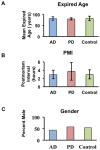Profiles of extracellular miRNA in cerebrospinal fluid and serum from patients with Alzheimer's and Parkinson's diseases correlate with disease status and features of pathology
- PMID: 24797360
- PMCID: PMC4010405
- DOI: 10.1371/journal.pone.0094839
Profiles of extracellular miRNA in cerebrospinal fluid and serum from patients with Alzheimer's and Parkinson's diseases correlate with disease status and features of pathology
Abstract
The discovery and reliable detection of markers for neurodegenerative diseases have been complicated by the inaccessibility of the diseased tissue--such as the inability to biopsy or test tissue from the central nervous system directly. RNAs originating from hard to access tissues, such as neurons within the brain and spinal cord, have the potential to get to the periphery where they can be detected non-invasively. The formation and extracellular release of microvesicles and RNA binding proteins have been found to carry RNA from cells of the central nervous system to the periphery and protect the RNA from degradation. Extracellular miRNAs detectable in peripheral circulation can provide information about cellular changes associated with human health and disease. In order to associate miRNA signals present in cell-free peripheral biofluids with neurodegenerative disease status of patients with Alzheimer's and Parkinson's diseases, we assessed the miRNA content in cerebrospinal fluid and serum from postmortem subjects with full neuropathology evaluations. We profiled the miRNA content from 69 patients with Alzheimer's disease, 67 with Parkinson's disease and 78 neurologically normal controls using next generation small RNA sequencing (NGS). We report the average abundance of each detected miRNA in cerebrospinal fluid and in serum and describe 13 novel miRNAs that were identified. We correlated changes in miRNA expression with aspects of disease severity such as Braak stage, dementia status, plaque and tangle densities, and the presence and severity of Lewy body pathology. Many of the differentially expressed miRNAs detected in peripheral cell-free cerebrospinal fluid and serum were previously reported in the literature to be deregulated in brain tissue from patients with neurodegenerative disease. These data indicate that extracellular miRNAs detectable in the cerebrospinal fluid and serum are reflective of cell-based changes in pathology and can be used to assess disease progression and therapeutic efficacy.
Conflict of interest statement
Figures





References
-
- Lau P, de Strooper B (2010) Dysregulated microRNAs in neurodegenerative disorders. Semin Cell Dev Biol 21: 768–773. - PubMed
Publication types
MeSH terms
Substances
LinkOut - more resources
Full Text Sources
Other Literature Sources
Medical
Molecular Biology Databases

